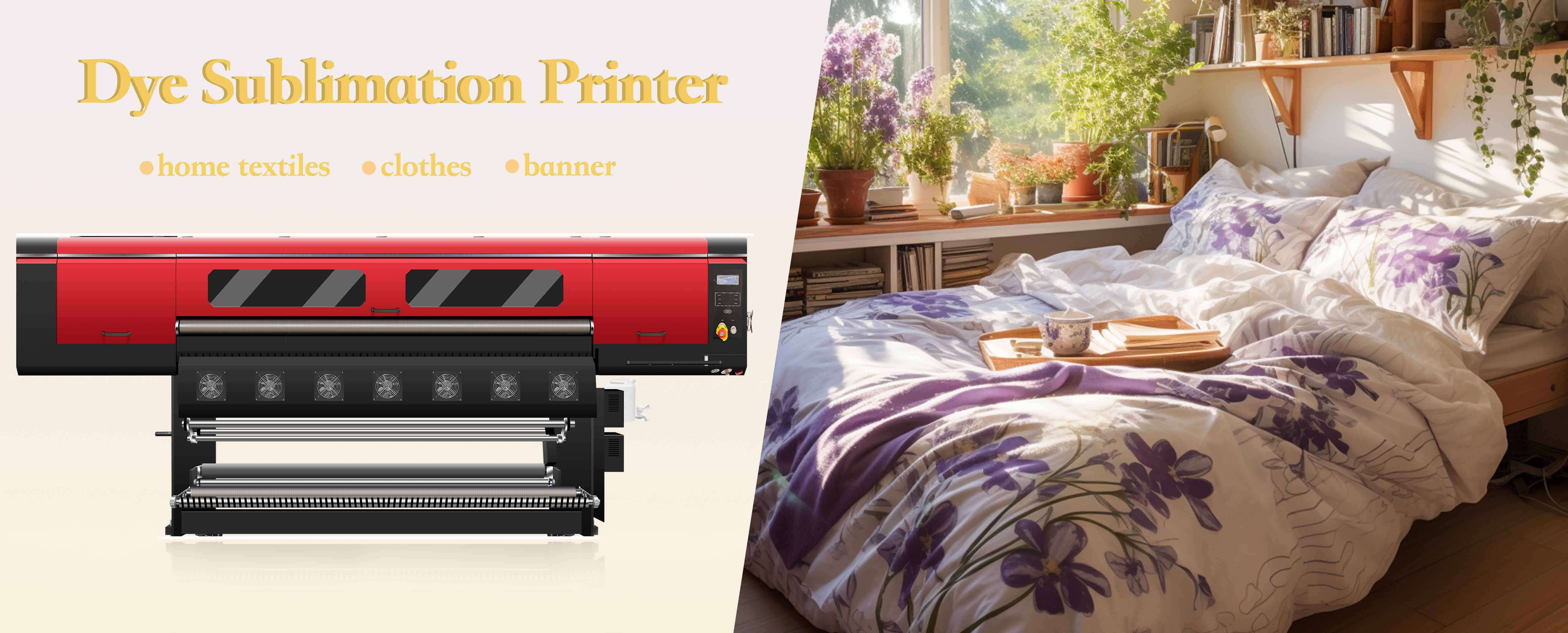
The science behind dye sublimation printers makes them an ideal technology for printing on polyester and similar materials. By utilizing wide-format inkjet or industrial dye sublimation printers, dye sublimation inks are printed onto specialized transfer paper. Through the printing process, we can directly transfer the prints onto fabric rolls or garments.
During the heating process, polymers undergo bonding, permanently embedding designs, graphics, or text into the fabric. The inks do not fade, peel, or deteriorate over time—making it perfect for high-traffic areas.
This guide covers most of what you need to know about fabric dye sublimation printers, enabling you to decide whether such a machine is suitable for your business.
Let's delve in!
What is Dye Sublimation Printing?
Dye sublimation printing involves applying images to fabric using heat transfer inks. The fabric uses a special type of ink with dispersed dyes or pigments for printing, followed by heat pressing or heat treatment to create a permanent, washable print.
The reason for using dispersed dyes is their excellent adhesion to polyester fabric during high temperatures, such as in the heat pressing process. Dye sublimation inks offer a vibrant color gamut, including fluorescent colors, to further enhance the color range of sublimation printing.
While other wide-format inkjet printers share similar features with dye sublimation printers, they are specifically designed for dye sublimation applications. The inks used are dispersed, dedicated for printing on transfer paper, and then heat-pressed onto textiles.
Where are Dye Sublimation Printers Applied?
Material-wise:
- Dye sublimation technology finds wide application in the printing industry, with printing on polyester fibers being the most ideal. During heating, polyester fibers slightly melt, allowing for a good bond with the dye and creating a permanent image transfer. Additionally, nylon, treated with additives for increased dye absorption, can also be used with dye sublimation technology.

Industry-wise:
- Dye sublimation printing technology can produce high-quality images, making it an ideal choice for creating exquisite T-shirts and banners. For printing companies, this means the ability to offer a broader range of products to meet the demands of customers seeking the highest quality.
- Furthermore, dye sublimation printers can capture stunning details, providing accurate physical representations for digital designs. This opens up new design opportunities for creating personalized products.
- Banners: Polyester and PVC banners are suitable for dye sublimation printing, allowing you to print images of any size, depending on the capabilities of your printer. Fabric banners can have UV resistance and permanent images suitable for any application.
- Soft Labels: Soft labels are another excellent use case for dry heat sublimation printing, allowing you to print on flags, notices, and display items.
- Interior Decoration: Customers purchasing banners and banners may also buy interior decorations, printing logos, brands, patterns, and designs on various fabrics used for home decor, such as curtains, tapestries, pillows, and wall coverings.
In summary, dye sublimation brings significant opportunities to commercial printing.
Pros and Cons of Dye Sublimation Printers
Pros:
- Fast printing speed
- High color reproduction
- Smooth feeding system
- Automatic ink switching
- Durable and long-lasting prints
- Pre-configured material profiles
- Industrial dye sublimation printers have production speeds exceeding 160 square meters per hour
Cons:
- Industrial dye sublimation printers are relatively large, occupying more floor space
- Printing process involves more steps
What Do You Need for Dye Sublimation?
To achieve dye sublimation printing, you'll need the following:
- Dye sublimation printer
- Dye sublimation paper for transfer
- Software to create files understandable by the printer
- Heat press machine
- Cutting mechanism, such as a rotary blade or cutting table
Why Choose Dye Sublimation?
Dye sublimation can create beautiful, high-quality graphics and images that accurately represent the original design. Dyes are embedded into the fabric, making them permanently effective for both indoor and outdoor use.
The lifespan of dye sublimation printed products is legendary, with images never fading, peeling, or degrading. If used outdoors, UV-resistant dyes can be specified to further extend the life of the images.
Is Sublimation Worth the Investment?
Of course! The demand for printed textiles is skyrocketing, and dye sublimation technology offers the best overall product quality. It also allows you to create a wider range of products.
Like any printing process, dye sublimation has its pros and cons. However, if you want to print high-resolution, permanent images on textiles, there's no other method that compares.
Contact us to experience the small yet impactful world of textile printing with dye sublimation printers!
